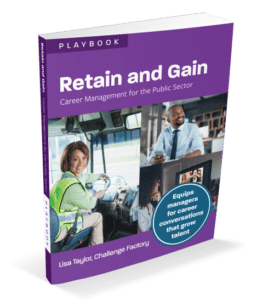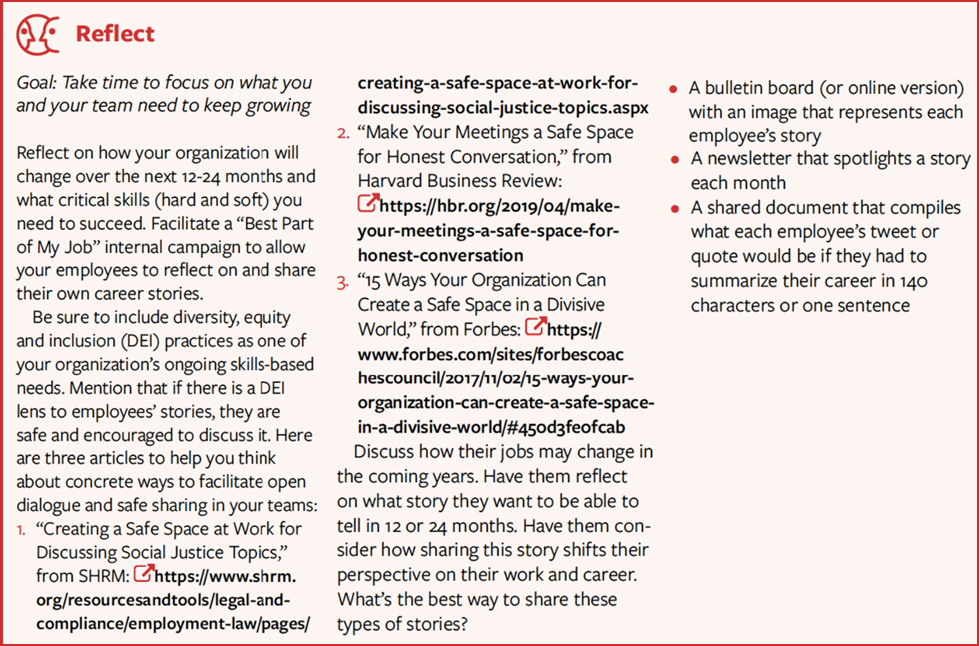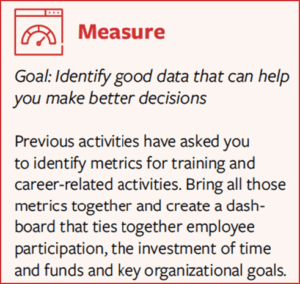By Taryn Blanchard
The third edition in our Retain and Gain career management playbooks is on virtual bookshelves now, and we are very excited to spotlight some of its key elements. This blog explores how the topic of diversity, equity, and inclusion (DEI) is integrated into the playbook.
Published by national nonprofit CERIC, Retain and Gain: Career Management for the Public Sector is designed to help leaders across the public sector—from frontline managers to senior directors, from municipal to federal organizations—attract, engage, and retain employees through low-cost, practical career management tips and activities.
“No resource focused on the careers of employees would be complete without the provision of tools to assist leaders in the pursuit of greater diversity, equity, and inclusion (DEI) in the workplace,” writes author Lisa Taylor, Challenge Factory’s president. “DEI is not a “special situation” to be addressed as something unique or optional and so, wherever possible, we have integrated these resources and activities into the main sections.”
DEI and career management
Applying a diversity, equity, and inclusion (DEI) lens in the workplace is not optional. Public sector leaders across Canada share this view, but don’t always know how to put it into practice in everyday career conversations or when following talent and performance management processes. A DEI lens is essential to creating equity and inclusion, upholding the fundamental human rights of employees (and Canadians more broadly), and creating an organizational culture in which a sense of belonging extends to everyone.
No resource focused on the careers of employees would be complete without tools that assist leaders in the pursuit of greater DEI in the workplace. Because DEI cannot be addressed as something separate from career management, wherever possible, we have integrated these resources and activities into the playbook’s main sections.
Quick and easy starting points
Canada’s public sector leaders don’t need to be convinced of the powerful role that both career management and DEI play in fostering talented, productive, future-focused workforces. What they need is an answer to the question: “Okay, what do you want me to do?”
There are over 40 activities in the Retain and Gain playbook to choose from depending on the amount of time you have available: 10 minutes a day, an hour a week, or a half-day every few months. In some of these activities, DEI is explicitly highlighted. In other activities, a DEI lens can and should be applied even when you’re not explicitly directed to do so. Let’s look at a couple examples that use career stories as a tool for employee engagement.
 Brainstorming activity
Brainstorming activity
Career management is a two-way street, and connecting with employees by sharing your own career stories is a great way to build an inclusive work culture, start career conversations, and learn from each other. Brainstorming stories to share also allows you to consider how DEI has impacted your own career—creating barriers you have had to overcome or privileges you have benefitted from—and how your experience differs from those of your employees. This type of awareness will make you a better career enabler, and it’s an important foundation for building cultural competence for the career conversations you have with employees.
This brainstorming activity only has to take ten minutes of your time. If you want to build it into a team exercise for a quarterly staff meeting or an ongoing team communication, consider the next activity.
Measurement activity
Another activity in the playbook invites managers to identify or bring together metrics for training and career-related activities (see page 45 of the playbook for the full activity instructions). This activity can be conducted by the manager independently or as part of a team exercise that promotes open collaboration and communication. It is not designed to be a wider institutional tool. Instead, it provides space for managers who want to take concrete action to think about meaningful metrics related to DEI and career management that they can impact.
For example, how many members of marginalized groups are offered the types of informal professional development opportunities described above? How might these opportunities have a positive effect on employees? Are there opportunities to gather employee feedback that surfaces differences in experiences related to career barriers and obstacles?
Recognizing how “opportunity structures” work and impact an employee’s career path is a critical part of a leader’s career management competence.
Reflection activity
DEI is inextricably linked to organizational, workplace environment, and employee growth. This reflection activity promotes understanding of how past career experiences fuel current career patterns, including the role that identity and inclusion might have played. By sharing your reflection, you can foster open dialogue and gain valuable insight to provide future-focused supports as employees continue to write their own career stories.
The importance of open communication about career goals, work satisfaction, and work culture is highlighted throughout the playbook. It also encourages managers to find creative ways to offer professional development opportunities to their employees, such as an assignment on an interesting project, committee, or taskforce, lunch with a difficult-to-access leader, or an email thanking an individual for a specific contribution.

Take action (It starts with you)
Managers have told us that career conversations can feel risky. What if a topic comes up for which they don’t have a good response ready? Retain and Gain can help bridge these gaps.
The Clerk of the Privy Council and Secretary to the Cabinet, Ian Shugart, released a call to action on anti-racism, equity, and inclusion in the federal public service that highlights the importance of shifting from knowing something has to be done to actually doing it.
Mr. Shugart emphasizes the need for leaders to invest in developing inclusive leadership skills and in establishing a sense of belonging and trust for all public servants (both current and future employees), regardless of race, ethnicity, sex, age, disability, sexual orientation, or gender expression by:
This call to action is relevant to all leaders across the public sector—not just at the federal level. The specific and meaningful actions that are listed also map well to the practical activities in this new edition of Retain and Gain, and we invite you to keep them in mind when exploring and selecting from the playbook’s activities.
Canada’s public sector leaders work hard to improve the lives and well-being of Canadians while building strong and diverse workplaces. Concrete, actionable resources that integrate DEI into career management are increasingly needed to equip them to do this work. Effective career management will play a key role in the growth of Canada’s public sector as we all recover from the COVID-19 pandemic, reckon with the systemic and structural barriers that continue to impact the career success of employees, and shape the Future of Work we want for ourselves and the next generations.
As the OECD’s Anthony Mann notes, “never before in human history has career guidance been more important.”
Get your copy of Retain and Gain: Career Management for the Public Sector.
Explore Challenge Factory’s other publications, including our Retain and Gain playbooks for small business and non-profits and charities.
“Finally! A comprehensive resource that is practical and speaks to the benefits of career planning while providing free tools and pathways that recognize our busy work lives. This should be saved on the desktops of all public service people-management leaders. This compendium is designed for the realities of public service managers and employees; their pressures, challenges and opportunities. We are facing complex demographic challenges, societal movements and digital transformations, which have been fast-tracked over the past year and which deeply influence who we are, what we do and how we serve Canadians.
As the public service readies itself for the culture shift for the future of work, and responds to the calls to action on addressing systemic racism, diversity and inclusion, this Playbook comes at a critical time to help understand how career conversations are essential to align talent with the organizational needs of today and tomorrow…now.”

 Brainstorming activity
Brainstorming activity